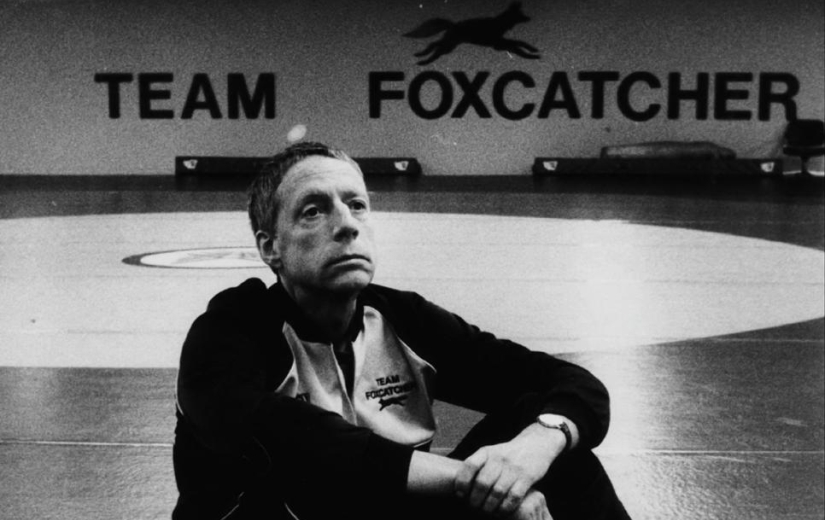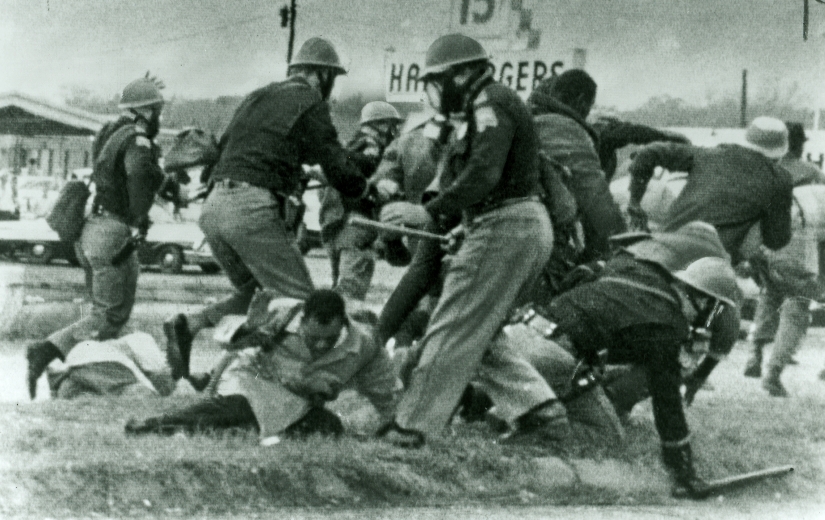Last week, Olympic wrestler Mark Schultz took to Twitter and Facebook to lash out at filmmaker Bennett Miller. Schultz is one of the subjects portrayed in Miller’s latest film, Foxcatcher, which stars Channing Tatum, Steve Carell, and Mark Ruffalo. Adam B. Vary at Buzzfeed has cached Schultz’s posts, which have been deleted from his social media accounts. “YOU THINK I’M GOING TO SIT BACK AND WATCH YOU DESTROY MY NAME AND REPUTATION I SWEAT BLOOD FOR,” one tweet reads. “YOU AINT’ SEEN NOTHING YET DUDE.”
Foxcatcher focuses on the relationship that multi-millionaire John du Pont (played by Carell) developed with Schultz (played by Tatum) when establishing a wrestling training camp on the du Pont estate. Though never stated overtly, it’s implied that du Pont is sexually attracted to Schultz. Miller—whose previous films, Moneyball and Capote, were also based on true stories—plays with the imagery and cliches associated with this awkward sexual dynamic. Hunky house guest Tatum is down on the mat with the effete yet maybe-too-enthusiastic Carell. In one sequence, Du Pont gets Schultz hooked on coke, and Schultz neglects training in a haze. Time passes off camera, the audience fills in the blanks. The next scene we see Schultz’s character, he’s upset and coked out and drunk, his hair bleached a cute California-dude blond.
On Facebook, Schultz called this implication of sexual relationship “a sickening and insulting lie” that jeopardized his legacy.
The Foxcatcher flare up and ongoing controversy surrounding the depiction of President Lyndon Johnson in Ava DuVernay’s Selma got me thinking about the challenges that go into turning real life events into films. When fiction is based on a true story, the notion of true may have less to do with the facts and more to do with a contour of history and a shape of narrative. The phrase to emphasize is sometimes “based on” rather than “true story,” though “true” is tricky too.
[youtube id=”x6t7vVTxaic” align=”center” mode=”normal” autoplay=”no” maxwidth=”829″]
For Selma, the controversy stemmed from two guest columns by stewards of President Johnson’s legacy. The first was “What Selma Gets Wrong” by Mark K. Updegrove on Politico, published just days before Selma‘s limited Christmas release. Updegrove is director of the L.B.J. Presidential Library and Museum and author of a book on the late president called Indomitable Will. The primary focus of Updegrove’s piece is the portrayal of Johnson (played by Tom Wilkinson) as an impediment to Dr. Martin Luther King, Jr. (played by David Oyelowo) rather than a clear partner in the Civil Rights Movement. Updegrove presents Johnson’s political priorities in terms of pragmatism, and that the later passage of the Voting Rights Act in 1965 as a strategic delayed move that allowed the passage of the Civil Rights Act in 1964.
Updegrove writes, “At a time when racial tension is once again high, from Ferguson to Brooklyn, it does no good to bastardize one of the most hallowed chapters in the Civil Rights Movement by suggesting that the President himself stood in the way of progress.”
Published the day after Christmas, Joseph A. Califano, Jr.’s piece in The Washington Post, “The Movie Selma Has a Glaring Flaw,” added to the scrutiny. Califano was President Johnson’s top assistant for domestic affairs from 1965 to 1969, and the crux of his piece, like Updegrove’s, is that Johnson and King were partners rather than uneasy allies. It should be noted that Califano’s own flaw in his chain of argument comes early when he writes that the Selma march was Johnson’s idea all along. Regardless, he raises interesting points about the disjunction between the history he feels intimately familiar with and the way certain events are depicted in the film.
“All this material was publicly available to the producers, the writer of the screenplay, and the director of this film,” Califano writes. “Why didn’t they use it? Did they feel no obligation to check the facts? Did they consider themselves free to fill the screen with falsehoods, immune from any responsibility to the dead, just because they thought it made for a better story?”
Maybe. But it’s also more complicated than that.
[youtube id=”8361stZ8n0w” align=”center” mode=”normal” autoplay=”no” maxwidth=”829″]
There’s a large question of legacy in these separate grievances against Foxcatcher and Selma. Legacy can trump the messiness of real life and complexities of history because legacy refers to an enduring notion that supplants the facts of an individual life. Legacy is no longer concerned with “This is what I experienced” so much as “This is how I will be remembered,” and that distinction is important—it’s the difference between the actual person and the idea of the person.
In the case of Schultz, there’s a potentially harmful stigma that may be attached to him because of Foxcatcher. (Schultz’s beef is entirely with Miller and not with Tatum, whose performance he’s continued to praise.) Sure, Schultz’s name’s out there again, but contrary to the cliche, there is such a thing as bad publicity. The troubled, underachieving, and self-destructive side of his character in the film can be potentially damaging to his future earnings as a public speaker and life coach. When Schultz detailed the differences between his life and the Foxcatcher‘s depiction of it, part of it seemed like clarification and part of it a CV.
With world leaders, the question of legacy is even greater, and Updegrove and Califano’s stewardship of Johnson’s legacy is to be expected. Califano’s overreach attributing the Selma march to Johnson may be part of that narrative-making and myth-making nature of legacy, and it’s something that stewards of a political figure do. People are more complicated than their legacies, obviously, and there are some quotations (albeit some of dubious attribution and) from Johnson that are tinged with the casual racism of his era. Johnson’s a product of his time, and each era may have ceilings for progressive sentiments for segments of the population. If the enduring legacy for Johnson is The Great Society, the Johnson seen in Selma may cause audiences to question the president’s commitment to his idea. The stewards want to make sure the man and the legacy are viewed as commensurate rather than separate.
For the filmmakers, notions of history and legacy are often secondary to concerns of narrative, and if there’s one certainty, it’s that lived-life generally doesn’t have the arc of narrative-life.
Lived-lives are messy, lumpy, not-so-neat things, and to try to condense the events of a life down into a story that satisfies is difficult if not impossible. Even individual events in a life aren’t so neatly compartmentalized to prove satisfying. There’s a whole chain of cause and effect to consider, and complicated interactions, and seemingly insignificant moments that are charged with actual significance, and, of course, all the boring bits. The facts of lived-life become condensed, merged, filtered, omitted, and transformed when adapted to a retelling as part of this challenge of crafting narrative-life from lived-life. (The problem with most biopics is that they’re usually just sketches or caricatures of their subject with gestures, some subtle and others overwrought, at an overarching story.)
In other words, like David Byrne sang: “Facts are simple and facts are straight / Facts are lazy and facts are late / Facts all come with points of view / Facts don’t do what I want them to.”
Filmmakers also have a certain distance from the events themselves and the historical players in the events, which leads to different takes on what unfolded. In Miller’s case, he had access and cooperation from Schultz during the making of Foxcatcher, but since he wasn’t a participant in the actual events, he comes at the material from a different point of view. For DuVernay and Selma, there’s a generational distance to consider in her approach to the material, a component of race as well, and even a distance from one legacy (Johnson’s) in order to focus on humanizing another legacy (King).
But in addition to facts and distance, there’s also a question of individual concerns and point of view. Miller found certain aspects of Schultz’s and du Pont’s story interesting and chose to explore them in a way that appealed to his sensibilities, and DuVernay similarly found her own interests in the Selma march and tried to explore them. These unique concerns from Miller and DuVernay play roles in their depiction of actual people, actual events, and even the fictional elements that play with actual events. Creation and invention become necessary as part of making story-life. Even when the film is ostensibly about real life, it’s at best an approximation, though hopefully the inventions are as carefully considered as the facts. (Inventions and omissions make their own difficulties in based-on-true-story stories. Take the Jimi Hendrix domestic abuse allegations in John Ridley’s Jimi: All Is By My Side and the glossing over Alan Turing’s persecution for being gay in Morten Tyldum’s The Imitation Game.)
The ultimate difficulty of adapting real life to the screen is this parallax view of history. Different players in the actual events and different participants in the recreation and evaluation of these events will necessarily see something different or know something more or interpret a moment in a way someone else hasn’t. It’s the messy tangle when legacy narratives and historical narratives and the demands of narrative per se weave with the interests and obsessions of filmmakers.
The mess is unavoidable. But maybe it’s also a necessary process, not just of filmmaking and adaptation but of how we revisit and reevaluate news and history. Consider Angelina Jolie’s Unbroken, a biopic about Jack O’Connell, which was met with mixed reviews for being too neat and one note, perhaps too obsessed with the legacy rather than the actual man.
There’s rarely a single definitive text about history, or a single narrative about what happened in an event. While potentially problematic, these films based on true stories can add an additional dimension to what’s occurred, another shift in the angle of observation. The distance from an event allows for a potentially valuable perspective—not necessarily better or worse but just worthwhile.
Maybe the closest we can get is something true enough in general, even if moments in a film are disputed as acts of truthiness or outright fabrications. From there, we can then parse out the fictions and the intentions of the creators and consider how story-life and lived-life play into the overarching narrative of the film and the overarching scope of history.
It’s a cop out of an answer, sure, but it’s pretty honest.


